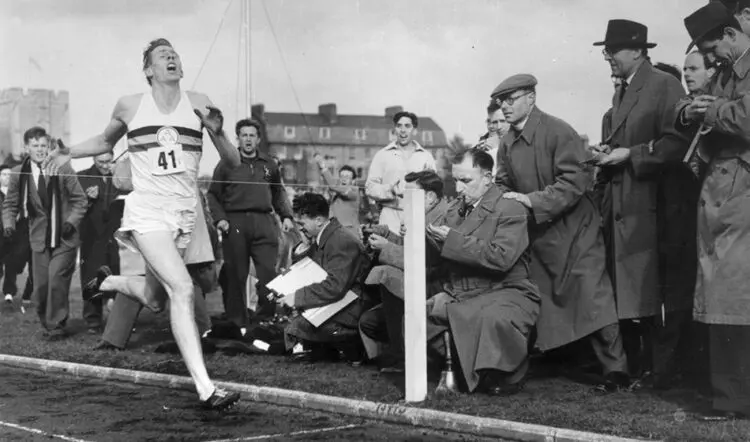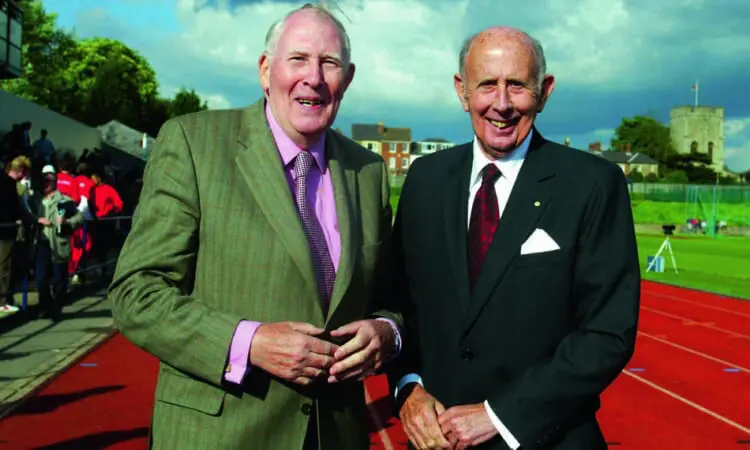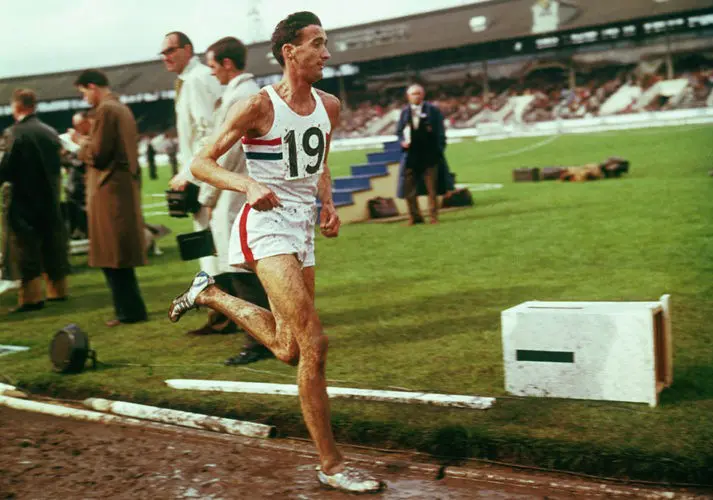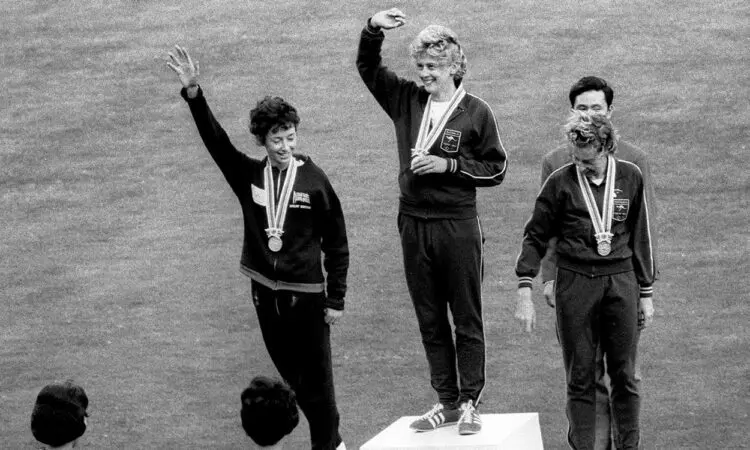We look at some of the finest performances from the 1950s in our 'greatest moments' series to mark the 80th anniversary of AW
Pioneering Parry
American Parry O’Brien revolutionised the shot put in 1951 when he used a method that saw him face the back of the circle before rotating his right foot through 180 degrees and then releasing the shot. It didn’t take long to become known at the “O’Brien Glide” and helped him become the first man to throw 18.00m, in 1953.
Zatopek’s Helsinki hat-trick
Emil Zatopek very nearly didn’t make it to the 1952 Helsinki Olympics. He had missed the initial flight which carried his nation’s Olympic team to Finland because he was standing up for his friend.
At the time, the nation then known as Czechoslovakia was under Communist rule where opponents of the revolution paid dearly for their views. The father of Zatopek’s team-mate Stanislav Jungwirth had been imprisoned for political offences and the 1500m athlete was told he was forbidden from travelling to the Olympics as a result. Upon hearing the news, Zatopek – the most famous member of the Czech team – refused to go.
He and Jungwirth did finally make the trip but taking such a stand meant that anything less than outstanding Olympic success could come with a very heavy price.
Typically of Zatopek, however, he excelled and went one better than his stated aim of 5000m and 10,000m victory, He won the marathon, too.

It was a hat-trick that had never been done before and almost certainly never will be again.
In the 5000m, a late surge overwhelmed the opposition and Zatopek hit the line in a then Olympic record of 14:06.6 while the 10,000m brought with it another Olympic record, 29:17.0.
Then came the marathon. Zatopek had only decided to make his debut over the 26.2-mile distance at the very last minute but, with the capacity crowd chanting his name in unison as he entered the stadium, he crossed the line in another Olympic record, 2:23:03, winning by over two minutes.
Bannister’s breakthrough
With what is arguably the most significant athletics performance of modern times, Roger Bannister created history when he clocked 3:59.4 to break the four-minute-mile barrier at Iffley Road on May 6, 1954.
Helped by his training partners and pacemakers Chris Brasher and Chris Chataway, Bannister scaled the Everest of athletics.
AW’s original report appeared in the May 15 issue in 1954 and was written by George Pallett, a British long jump international and athletics writer who died in 1996 aged 88.

Pallett wrote: “So the Everest of athletics has been scaled, the sound barrier of running has been penetrated. Roger Gilbert Bannister, 25-year-old medical student, may never find the panacea for all ills the human flesh is heir to, but he has found the philosopher’s stone of sport.”
On the closing stages of the race, Pallett continued: “An avalanche of humanity began to pour from the stands as Bannister was seen to draw out and begin the last, long pull to the tape; a slight lengthening of the stride, his arms driving harder to maintain the almost majestic cadence of his action – his fluent power gave no hint of fatigue.”
Diane Leather sub-five mile
Just 23 days after Roger Bannister’s history-making sub-four-minute mile, Diane Leather made a similar breakthrough that received far less acclaim.
Racing at the Midland Championships in Birmingham, she clocked 4:59.6 to become the first woman to cover the distance in under five minutes. Given the status of women’s athletics at the time it is perhaps little surprise she is not a bigger name. It was not until 1967 that the IAAF first recognised women’s world records for the mile and it was only after that that women ran the distance at international level.
Perry Barr Stadium was the scene for Leather’s historic feat, but she was clearly capable of going much faster given her slightly erratic splits of 68.8, 2:27.00 and 3:48.6.
The miracle mile
The newly constructed Empire Stadium in Vancouver was the setting for a clash of athletics heavyweights at the 1954 British Empire and Commonwealth Games in Vancouver.
On August 7, Roger Bannister came face to face with John Landy, who had replaced him as the mile world record-holder with an official time of 3:58.
Promoted as “The Mile of the Century,” it would later be known as the “Miracle Mile.”
It was the Australian who led into the closing stages, and looked over his left shoulder to check where Bannister was. Just as he did so, the Englishman flew past to win in a Commonwealth record time of 3:58.8. Landy finished in 3:59.6, marking the first time that the four-minute mile had been broken by two men in the same race.

Chataway gets the better Kuts
Regarded as perhaps the most thrilling footrace to have taken place on British soil, Chris Chataway outsprinted Vladimir Kuts in front of a huge audience at White City over 5000m in October 1954. It earned Chataway the BBC Sports Personality of the Year award.
His time was a world record of 13:51.6 but it was the nail-biting victory in this London v Moscow match, watched by a television audience of 15 million, that captured everyone’s imagination.
AW founder and editor Jimmy Green wrote: “It is surprising how the Kuts-Chataway duel at the White City stirred people who, in the past, have shown little or no interest in athletics.”
He added: “This shows how such races – and the televising of them – can stimulate interest in our sport.”
Kuts would go on to win the 5000m and 10,000m at the Melbourne Olympics.

Pirie’s record-breaking summer
Gordon “Puff Puff” Pirie might not have won an international title but he was one of Britain’s greatest ever distance runners and enjoyed the summer of his life in 1956. The man who gave up a career in banking to concentrate on his sporting career broke a total of five world records, three of which came within the space of three months.
Firstly, he defeated Vladimir Kuts (to whom he finished second in the Olympic 5000m final that year) to knock 3.8 seconds off the 5000m record with a run of 13:36.8. He followed that up by lowering the 3000m record to 7:55.5 and then 7:52.7. He had set world records at 6 miles and the 4x1500m relay in 1953.
Cuthbert becomes Australia’s golden girl
Betty Cuthbert initially expected to attend the Melbourne Olympics of 1956 as a spectator, having bought tickets for herself to go along and watch. Instead, however, the then 18-year-old qualified for the Australian team and became the home star of the Games thanks to some stunning performances across six eventful days.
On November 26, she stormed to women's 100m gold in a time of 11.5 before completing the sprint double four days later with 200m victory in 23.4.

On December 1, she then combined with Norma Croker, Fleur Mellor and Shirley Strickland to win the 4x100m in a world record of 44.65.
After injury hampered her 1960 Olympics, Cuthbert announced her retirement but her hiatus didn’t last long and, in Tokyo four years later she became the first ever women’s 400m champion and the first woman to win gold medals at 100m, 200m and 400m.
Brasher bounces back
Having finished second-last in the Olympic men’s 3000m steeplechase final four years previously, Chris Brasher was determined to do much better in Melbourne and took a sabbatical from his job with an oil company to focus on his preparations.
The move paid off as he struck gold, but it was not without controversy. The man who would go on to co-found the London Marathon was initially disqualified for an alleged blocking of Ernst Larsen of Norway but he launched an appeal and persuaded the other medallists from the race to support him.
Brasher’s celebrations were less than reserved and, following a “liquid lunch” with the British press he admitted to being “blind drunk, totally blotto” when he collected his medal on the top step of the podium the following day.
Did you know?
Emmanuel Arinze Ifeajuna of Nigeria became the first black African to win a major championship title with high jump gold at the 1954 British Empire and Commonwealth Games.

